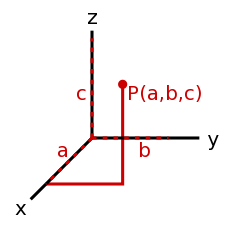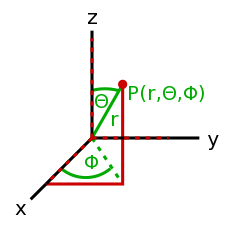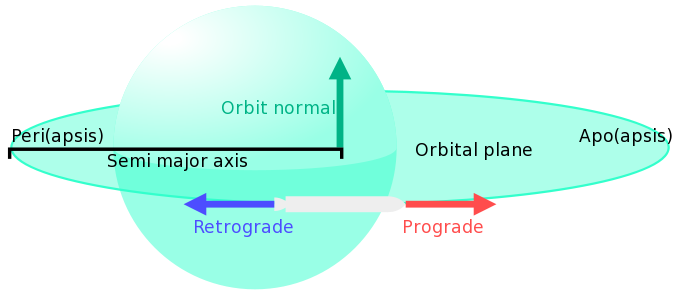Difference between revisions of "Terminology/de"
From Kerbal Space Program Wiki
Burzelmann (talk | contribs) (→Mathematik & Geometrie) |
Burzelmann (talk | contribs) m |
||
| Line 2: | Line 2: | ||
In KSP gibt es viele Begrifflichkeiten bzgl. Orbits und Physik, die auf einen Nicht-Techniker verwirrend wirken können. Zusätzlich werden viele allgemeine Vorgänge mit wissenschaftlichen Begriffen oder Abkürzungen beschrieben. | In KSP gibt es viele Begrifflichkeiten bzgl. Orbits und Physik, die auf einen Nicht-Techniker verwirrend wirken können. Zusätzlich werden viele allgemeine Vorgänge mit wissenschaftlichen Begriffen oder Abkürzungen beschrieben. | ||
| − | Dieses Blatt soll ein | + | Dieses Blatt soll ein zusammengefasstes Nachschlagewerk der notwendigsten Begriffe sein um dir auf deinem Weg zum erfolgreichen Astronauten zu helfen! |
== Hilfreiche Begriffe == | == Hilfreiche Begriffe == | ||
Revision as of 09:31, 13 April 2013
In KSP gibt es viele Begrifflichkeiten bzgl. Orbits und Physik, die auf einen Nicht-Techniker verwirrend wirken können. Zusätzlich werden viele allgemeine Vorgänge mit wissenschaftlichen Begriffen oder Abkürzungen beschrieben.
Dieses Blatt soll ein zusammengefasstes Nachschlagewerk der notwendigsten Begriffe sein um dir auf deinem Weg zum erfolgreichen Astronauten zu helfen!
Contents
Hilfreiche Begriffe
Mathematik & Geometrie
- Elliptisch
- Oval geformt, bezieht sich meist auf die Form eines Orbits.
- Normalenvektor
- Ein Vektor der senkrecht auf/zu einer Ebene steht.
- Skalar
- Ein Einzelwert ohne Richtung. Normalerweise folgt einem Skalar eine Maßeinheit um zu beschreiben, welche Dimension der Skalar hat z.B. sind 3 m/s, 3 m,3 s skalar: sie besitzen Einheiten, die Geschwindigkeit, Strecke/Distanz bzw. Zeit angeben, haben aber keine Richtung.
- Vector
- Eine Kombination aus einer Richtung und einem Wert, z.B. ergeben Flugrichtung (engl. heading) und Geschwindigkeit zusammen einen Vektor. Wie ein Vektor ausgedrückt wird, hängt vom verwendeten Koordinatensystem ab und wie viele Dimensionen mit einzubeziehen sind. <35°, 12> ist ein zweidimensionaler polarer Vektor, wohingegen <14, 9, -20> ein dreidimensionaler kartesischer Vektor ist. Es gibt zwar auch andere Koordinatensystem, diese beiden sind aber die am häufigsten verwendeten.
- <35°, 12> sieht wie ein 12 Einheiten langer Pfeil aus beginnend am Ursprung Null(der Winkel ist hier nicht von Belang, da es sich um einen Punkt ohne Länge handelt) und endend an einem Punkt 35° (und 12 Einheiten) von der Grundachse (normalerweise die x-Achse, positive Winkel laufen gegen den Uhrzeigersinn)
- <14, 9, -20> sieht wie ein Pfeil aus beginnend am Ursprung (<0,0,0>) und endend an einem Punkt mit der x-Koordinate 14, der y-Koordinate 9 und der z-Koordinate -20.
- Der Vorteil kartesischer Koordinaten ist, dass man den Endpunkt ganz genau kennt. Dafür ist es schwieriger die Länge zu bestimmen, was im sphärischen Koordinatensystem kein Problem darstellt. Im sphärischen Koordinatensystem ist es hingegen schwieriger die Position herauszufinden.
- Folgende physikalischen Eigenschaften sind alle Vektoren: Geschwindigkeit, Beschleunigung, Kraft
Ein dreidimensionales Koordinatensystem benötigt:
- Einen Bezugspunkt (welcher dem Ursprung entspricht).
- 3 Achsen (Vektoren). Diese bestimmen die grundlegende Maßeinheit der Messung entlang einer Achse und in Richtung dieser Achse.
- Eine Kombination aus 3 Skalaren, die entweder Winkel oder Koordinaten sein können, um Punkte/Orte im Koordinatensystem zu beschreiben.
Orbital Terms
- Apoapsis
- In an elliptical orbit, the point of the orbit farthest from the planet.
- Periapsis
- In an elliptical orbit, the point of the orbit closest to the planet.
- Peri-* and Apo-*
- When speaking of orbits, oftentimes you replace the "-apsis" of Periapsis and Apoapsis with something signifying which planet you are speaking of. In this game, -kee and -kerb are both commonly used to describe orbits around Kerbin resulting Perikee/Perikerb and Apokee/Apokerb.
- Ascending Node
- The point at which the orbit crosses the reference plane moving north. Here, "north" means the direction of the orbit normal of the reference plane.
- Descending Node
- The point at which the orbit crosses the reference plane moving south.
- Eccentricity
- A scalar describing how non-circular an orbit is.
- ecc = 0 → circular orbit.
- 0 < ecc < 1 → elliptical orbit.
- ecc = 1 → parabolic orbit - this is an escape orbit.
- ecc > 1 → hyperbolic orbit - this is an escape orbit.
- Inclination
- The angle between an orbital plane relative to a reference plane (e.g. an orbit with 90° inclination to an equatorial reference plane would be called polar).
- Low Kerbin Orbit
- Also known merely as LKO. A "low orbit" exists for most planetoids with a gravity well. It describes an orbit that is low, but stable (above atmosphere). Low orbits are used as stepstones, after ascent and before burning to another rendezvous object (planet/vessel), as it allows to perform the exit burn at any point of the orbit. The upside is that it requires the least possible amount of fuel to reach a low orbit.
- Zenith
- "Up" in ground-relative coordinates, i.e. the direction your rocket points at when at the launchpad, aka: "the highest point in the sky".
- Nadir
- opposite direction of "Zenith".
- Orbital Nodes
- Specific points of reference in any orbit such as Apoapsis, Periapsis, intersect points with other orbits etc.
- Orbit Normal
- A normal vector of the Orbital Plane. Produced by cross multiplying the ship's velocity and gravity. Since this follows the right hand rule, from a perspective where the ship is orbiting counter-clockwise it will point "up", while for a ship orbiting "clockwise" it will point down. "Up" is also often labeled as "North" or "N+", and in tandem with that "Down" is labeled "Anti-Normal", "South" or "N-".
- Orbital Plane
- The imaginary disk described by the path of an orbit around a body (commonly used when describing inclinations).
- Prograde
- The "Direct" direction of your orbital path. Since orbits are elliptical, it's actually the tangent of the orbit where the ship is.
- Retrograde
- The reverse of Prograde, "backwards".
- Reference Plane
- Any plane used as a reference for describing your current orbit. For local orbits around a planet, this is often the equatorial plane. When multiple bodies in a solar system are involved, the ecliptic plane can be used. For intercepting another orbiting body, the orbital plane of the body to be intercepted is used. An orbital plane can be fully described by giving the inclination and the longitude of the ascending node relative to a reference plane.
- Semi-major axis
- The major-axis is the long axis of an ellipse, and the semi-major axis is half of this. In KSP the semi-major axis is calculated with . It's the average of the Apoapsis and Periapsis computed relative to the center of the body. As both are relative to the bodies surface, the radius must be added. All orbits with the same semi-major axis have the same period, regardless of their eccentricity.
- Sub-Orbital
- Describes an orbit where the periapsis is below the surface of a planetary body, leading to an impact on said body.
- Thrust-Weight-Ratio
- TWR in short. The Ratio between the total mass of the vehicle and the available thrust of all propulsion devices of the vehicle. TWR > 1 means you will have enough thrust to accelerate and ascend. A TWR below 1 means you will not be able to counteract gravity and drag at low altitudes (though a low TWR might totally suffice in space).
Space Maneuvers
- Atmospheric Braking
- → Main article: Aerobraking
- Lowering the periapsis so it is inside a planetary atmosphere. This will lead to the vessel being slowed by atmospheric drag. Can lead to reentry (see below), but also is used to reduce the necessary burn time for significant orbit alterations.
- Burn
- firing of the engines, usually to alter trajectory in some way.
- Circularizing
- a maneuver (firing of the engines) that makes an orbit's eccentricity 0, or close to zero. This is usually achieved by a burn close to an apsis.
- Re-entry
- Re-entering atmosphere and using drag to decelerate a vessel to a groundwards trajectory. This usually causes intense heat stress on the object as the vessel requires sufficient speed to not "bounce" back from the atmosphere into space. Currently re-entry is only partially implemented with effects but heat and bounce are not yet implemented. (There are mods however)
- Retroburn
- A burn performed "backwards", e.g. with the engines facing towards prograde and nose towards retrogade (hence the name). This is a common maneuver to used to lower the height of the orbit without altering any other orbital parameters.
Physics
- Acceleration
- Rate of change to your velocity. Acceleration is a vector, measured in "m/s2".
- Ballistic trajectory
- A falling object's trajectory is ballistic. In rocketry it usually indicates that the object in question is only influenced by gravity and does not exert any force (ie. thrust) of its own.
- Delta-v (Δv)
- The change in velocity that has or can be exerted by your spacecraft. This is measured in meters per second (m/s). More mass can reduce the delta-v, while more propulsion can increase it. This makes it a useful value to calculate efficiency of launch vehicles. For example, a launch vehicle requires about 4,000 m/s of delta-v to escape Kerbin's atmosphere and achieve a stable orbit.
- Energy
- The energy of an object in an orbit is the sum of its potential and kinetic energy. Potential energy is and Kinetic Energy where G is the gravitational constant, M is the mass of the planet, m is the mass of the vehicle, R is the distance from the center of the planet and v is the velocity. So . When the energy is greater than zero the vehicle is on an escape trajectory. All orbits with the same semi-major axis have the same energy.
- Escape Velocity
- The velocity needed to escape a given planet's gravity well.
- G
- A measurement of force as expressed in the sea-level force of Earth's gravity. In other words, right now you're under 1 G. 2 G's is equivalent to twice earths gravity at sea level, and so on.
- Gravity
- The force exerted by all objects with mass. Very weak. Usually only objects with very high mass - ie. planets, moons - have any noticeable effect. Diminishes with the square of distance from the center of mass. So for an object twice as far, experiences only 1/22 = 1/4 of the gravity.
- Gravity Well
- The area around a planet affected by gravity. Actually extends to infinity, but as gravity decreases exponentially with distance, it is only significant within the planet's sphere of influence.
- Orbit
- When an object has sufficient tangential velocity (and is outside the atmosphere, so drag won't slow it down) so that it will keep falling "next" to the planet (never touching ground) its trajectory is called an orbit. Stable orbits are elliptical (a circle is an ellipse with zero eccentricity). If the objects tangential speed exceeds escape velocity it's orbit will be either para- or hyperbolic.
- Sphere of influence
- The radius around a celestial body where its gravity well is non-neglectable. Commonly known as SoI/SOI.
- Tangential velocity
- The component of your velocity that's perpendicular to your trajectory. Instantaneous velocity - velocity when the time of measurement approaches zero - is always tangential to your trajectory.
- Trajectory
- A trajectory is the path that a moving object follows through space as a function of time.
- Velocity
- Rate of change of your position. Your speed and direction. Velocity is a vector, measured in meters per second (m/s).






